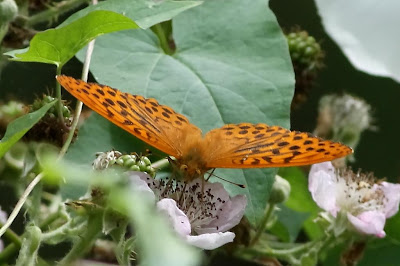Although there were still a few Common Blue Damsels about, there were nowhere near the numbers of a couple of weeks ago. I tried really hard to get some shots of the few Blue-tailed Damsels fluutering around but failed miserably. Broad Bodied Chasers were still in evidence and this obliging female settled up quite close to.
Nothing was on the nearest pylon, but the next one (which is quite a way off!) had a bird of prey on it. I couldn't and still can't be certain whether this is a Hobby or a Peregrine. Apologies for the poor quality of photos, its blown up as much as it can be,
The only other raptor about was one of the tattiest looking Buzzards I have ever seen. For those birders looking for Booted Eagles in Hampshire by counting "fingers", good luck with this one! I'm frankly surprised it allowed itself to be seen in public.
A Little Egret was stomping about in the distance and plenty of Grey Herons seemed to be flying in from all directions, and some of those were in little better shape than the Buzzard above. Around the back, warblers were on the whole quiet. Cettis Warblers only gave a half hearted occasional call, and even the Sedge Warblers were mostly in hiding.
Reed Warblers however popped up regularly to tell me off. As most of them are busy feeding young at the moment, I didn't hang around for more than a few minutes wherever I saw or heard them, but took a few hurried shots as one came out very much in the open. Why it is soaking wet I don't know, maybe a quick bath between deliveries.
Nearby, I managed not to spook a couple of Tufted Ducks who were in charge of around a dozen chicks. Getting close to any wildfowl here is not at all easy, so you will have to forgive these shots taken through Reed Mace. The blurriness is also probably partly due to being eaten alive by horseflies and resisting the temptation to smack at various parts of my body. Shorts were a mistake here.
Talking of Reed Mace, some new flowering heads were just emerging, and many more have already lost the male flowers from the top. I don't know why, but they always remind me of bearskins.
On the margins of the reedbed, Hedge Bindweed has escaped the confines of any hedge that may have once been there and swamps small areas of Reeds and Reed Mace. Much maligned by gardeners as a difficult weed to control, its persil white trumpets are no less spectacular than almost any treasured garden plant.
Another much hated plant is Ragwort. A real glow of sunlight in the flowers betrays its poisonous nature, but one creature thrives on it, the Cinnibar Moth caterpillar for whom it is its sole food plant. Its black and yellow stripes (known as aposematic colouration) advertise the poisons it stores from the plant and an unpleasant taste, and as with many such insects, it happily stays in large groups safe in the knowledge that very few predators will attempt to eat them, and even then, probably just the once. They will usually completely destroy one plant before moving on to the next. These are the first I have seen this year.
A long time ago, having read in some ancient herbal or another that the perfume of Meadowsweet could not be captured, I tried to make an extract of the flowers which ended up smelling quite unpleasant. The meadow part of the name is something of a corruption of the much older name of Meadsweet or Meadwort which has nothing to do with the meadows in which it grows, but everything to do with a flavouring used in mead.
I like an old Shetland name for it, Courtship-and-Matrimony, arising from the sweet smell before, and the rather carbolicy smell after crushing.
Of course many plants have been used as medicines through the ages, some with more justification than others, and a few carry names to suggest their use in times gone by. One such is Self-heal, a herb much vaunted as a vulnery (wound healer) by many generations of herbalists. Anyone who knows me who reads this will understand why its Latin name is indelibly etched in my brain. Prunella vulgaris.
On this example, a Small Skipper was finding plenty to feast upon.
Back up on the canal I came across a huge example of Figwort. Once used to cure the lesions caused by TB (and piles), this interesting plant usually grows between one and two feet high. This one however is taller than me, and I am not between one and two foot high. I wonder what the record for Figwort is.
Another Scarlet Tiger caught my eye on one of the thistle flowers.
It was sharing this nectar bounty with a Soldier Beetle below and a Longhorn Beetle above (at least I think thats what they are)
I waited what seemed like an age for it to fly to try and photograph it as it landed as it often takes them a few moments to sort their wings out and patience was in the end rewarded, although this shot reminds me very much of Darth Vader. Whilst I was waiting a Grasshopper Warbler started reeling close nearby, but I couldn't see it anywhere, at least I can only think it was a Grasshopper Warbler although it didn't sound quite right. Maybe it was because it was so close.
Back at the bridge, 3 or 4 large orange butterflies were mostly at tree top level, but just occasionally one would come down to feed on the brambles. Powerful fliers, and never still for long, they did present a bit of a challenge to photograph, but I was lucky on a few occasions to catch the odd one in focus. Silver-washed Fritillaries. Stunning butterflies.
Going up!

























No comments:
Post a Comment